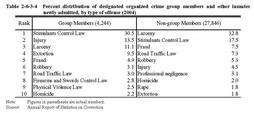| Previous Next Index Image Index Year Selection | |
|
|
2 Correction (1) Imprisonment of convicts related to organized crime groups Table2-6-3-3 shows the number of convicted inmates related to organized crime groups and their proportion to total convicted inmates over the last five years.
Table2-6-3-3 Number of convicted inmates related to organized crime groups and their proportion in total convicted inmates(As of December31in each year in2000-2004) (2) Characteristics of designated organized crime group members in newly admitted inmates (i) Status Among newly admitted convicted inmates in2004,4,244(13.2%of the total)were identified as members of organized crime groups(members of designated organized crime groups under the Anti-Organized Crime Group Law;hereinafter the same in this subsection).Of them,1,296were group leaders,2,580were regular members,and368were unknown(Source:Annual Report of Statistics on Correction).
(ii) Type of offense Table2-6-3-4 shows the10most common offenses committed by designated organized crime group members and by other inmates newly admitted in2004.
Table2-6-3-4 Percent distribution of designated organized crime group members and other inmates newly admitted,by type of offense(2004) (iii) Term of sentence Examining the term of sentence for designated organized crime group members newly admitted in2004,most of them were sentenced to over one year but not more than two years(36.4%),followed by over two years but not more than three years(24.5%),over three years but not more than five years(14.6%),over six months but not more than one year(13.3%),over five years(9.0%,including imprisonment for life),and not more than six months(2.3%)(Source:Annual Report of Statistics on Correction).
(iv) Age As for the age of designated organized crime group members newly admitted in2004,most of them were aged30-39(39.2%),followed by aged40-49(21.6%),aged20-29(20.8%),aged50-59(14.4%),and aged60or over(4.0%)(Source:Annual Report of Statistics on Correction).
(v) History of imprisonment As for the history of imprisonment of designated organized crime group members newly admitted in2004,the highest was"the first time"with32.2%,followed by"twice"with19.6%,"three times"with13.7%,"four times"with9.8%,"five times"with7.2%,"six to nine times"with14.1%,and"10times or more"with3.5%(Source:Annual Report of Statistics on Correction).
(3) Treatment Correctional institutions provide guidance for organized crime group members to acquire well regulated daily lives and working habits,and positively encourage them to leave their organized crime groups with the support of the police and other authorities.Organized crime group members are apt to cause security incidents by forming a group or bringing their rivalries even into penal institutions.While allotting work and rooms to them with special care,correctional institutions take necessary measures to maintain strict discipline and order in the institutions by housing them separately in the same institution or transferring them to other institutions.
|

